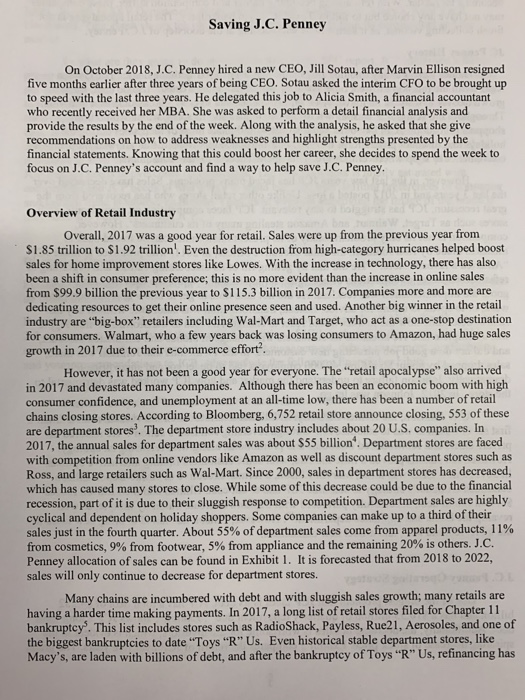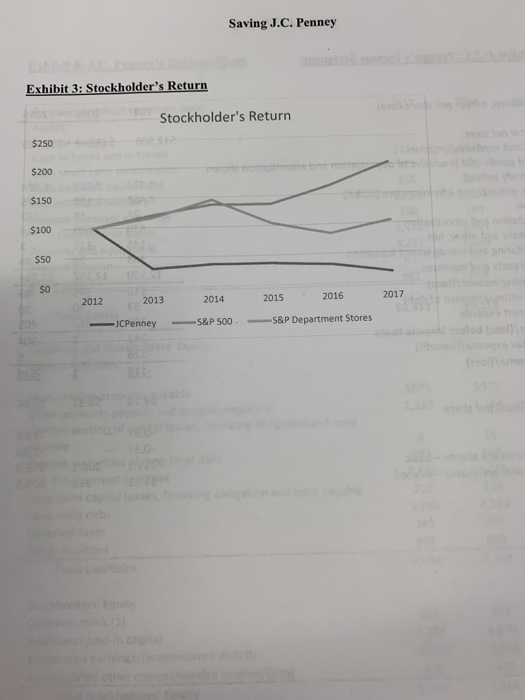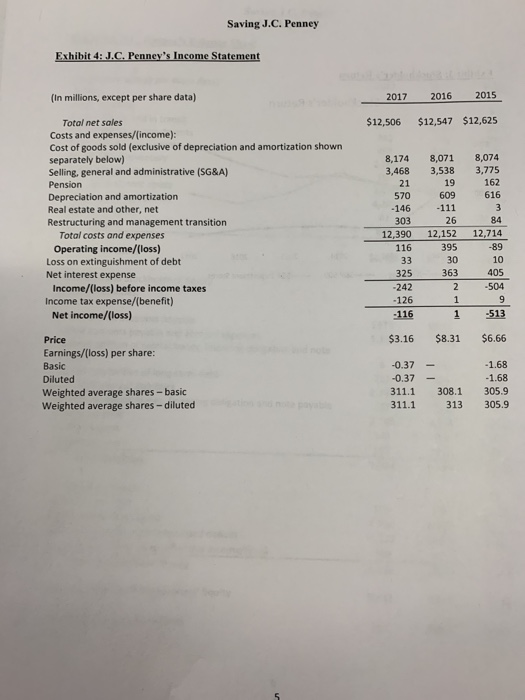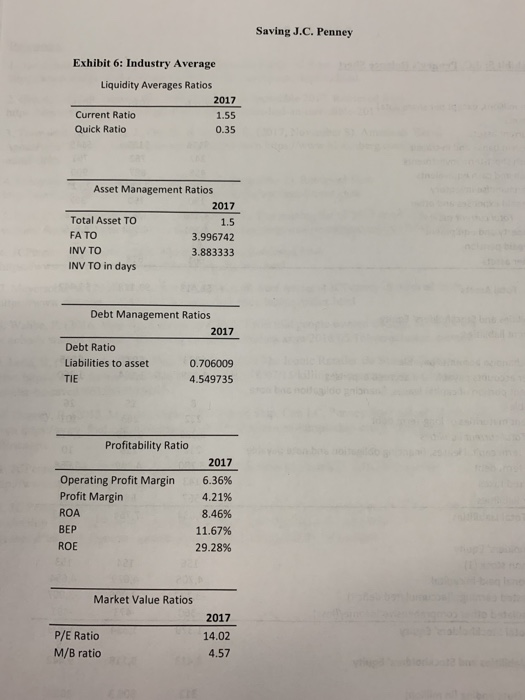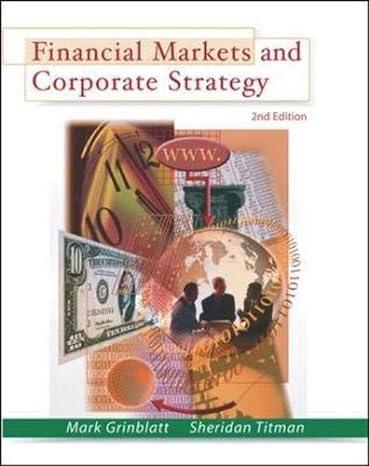Saving J.C. Penney On October 2018, J.C. Penney hired a new CEO, Jill Sotau, after Marvin Ellison resigned five months earlier after three years of being CEO. Sotau asked the interim CFO to be brought up to speed with the last three years. He delegated this job to Alicia Smith, a financial accountant who recently received her MBA. She was asked to perform a detail financial analysis and provide the results by the end of the week. Along with the analysis, he asked that she give recommendations on how to address weaknesses and highlight strengths presented by the financial statements. Knowing that this could boost her career, she decides to spend the week to focus on J.C. Penney's account and find a way to help save J.C. Penney Overview of Retail Industry Overall, 2017 was a good year for retail. Sales were up from the previous year from S1.85 trillion to $1.92 trillion'. Even the destruction from high-category hurricanes helped boost sales for home improvement stores like Lowes. With the increase in technology, there has also been a shift in consumer preference; this is no more evident than the increase in online sales from $99.9 billion the previous year to S115.3 billion in 2017. Companies more and more are dedicating resources to get their online presence seen and used. Another big winner in the retail industry are "big-box" retailers including Wal-Mart and Target, who act as a one-stop destination for consumers. Walmart, who a few years back was losing consumers to Amazon, had huge sales growth in 2017 due to their e-commerce effort However, it has not been a good year for everyone. The "retail apocalypse" also arrived in 2017 and devastated many companies. Although there has been an economic boom with high consumer confidence, and unemployment at an all-time low, there has been a number of retail chains closing stores. According to Bloomberg, 6,752 retail store announce closing, 553 of these are department stores3. The department store industry includes about 20 U.S. companies. In 2017, the annual sales for department sales was about $55 billion. Department stores are faced with competition from online vendors like Amazon as well as discount department stores such as Ross, and large retailers such as Wal-Mart. Since 2000, sales in department stores has decreased, which has caused many stores to close. While some of this decrease could be due to the financial recession, part of it is due to their sluggish response to competition. Department sales are highly cyclical and dependent on holiday shoppers. Some companies can make up to a third of their les just in the fourth quarter. About 55% of department sales come from apparel products, i i% from cosmetics, 9% from footwear, 5% from appliance and the remaining 20% is others. J.C Penney allocation of sales can be found in Exhibit 1. It is forecasted that from 2018 to 2022 will only continue to decrease for department stores Many chains are incumbered with debt and with sluggish sales growth; many retails are having a harder time making payments. In 2017, a long list of retail stores filed for Chapter 11 bankruptcy. This list includes stores such as RadioShack, Payless, Rue21, Aerosoles, and one of the biggest bankruptcies to date "Toys "R" Us. Even historical stable department stores, like Macy's, are laden with billions of debt, and after the bankruptcy of Toys "R" Us, refinancing has Saving J.C. Penney become a lot harder. With refinancing becoming harder and competition stiffer, these companies may not have any choice but to follow Toys "R" Us to bankruptcy. The retail apocalypse is not sh collecting victims, as it seems to be encroaching at the doorstep of J.C. Penney. JC Penney History James Cash Penney founded J.C. Penney (JCP) in 1902 with the name "The Golden Rule" with the mission to "treat others as they would like to be treated.6 Since then, it has grown to over 870 stores nationwide, 11 supply chains, and over 97,000 associates worldwide. Throughout the years, JCP was known for its catalogues and its sales, which would bring shoppers to its door. JCP, like other retail stores would make most of their sales during the holidays and discount promotions. In 1994, JCP introduced its website that allowed shoppers the convenience to shop wherever they are. This opened access to new consumers. However, in the last few years JCP has faced many problems. Sales have decreased over the last 3 years and in 2017 posted a loss. Unlike other retail stores who has recovered from the great recession, JCP has struggled to stay relevant. JCP faces competition on many fronts, with stores such as Target, Walmart, and Amazon stealing many of its custumers. However competition is not its only problem. Many of its present misfortunes can be traced back to mistakes made by Ron Johnson, the chief executive officer, in 2011, who promised to make JCP America's favorite store." "He did that by getting rid of its discounting culture and beginning to refashion its stores as collections of boutiques for hip brand" While the idea may have been good, the implementation was reckless. He did not take time to get to know how the company work, or to speak to others for advice. Instead, transformation was automatic without any test runs to determine how the market would react to change. His idea to transform JCP into Apple was a complete fail. He alienated its customers with change in brands and eliminated discount, and did not do a good job attracting new customers. In the 17-months that Johnson was there, sales dropped by about $6 billion, 40,000 employees had to be let go, and share price fell dramatically. Johnson failure to understand the market and how JCP worked was detrimental to the store. In 2012, Johnson was let go After Johnson, the former CEO Myron Ullman return to fill in the vacated role. Ullman's first set of business was to stabilize JCP through reversing Johnson's action. He restored the private labels and reintroduced discounts and promotions, along with releasing an apology However, his actions proved a little too late, with some customers finding alternative options In 2015, a new CEO was hired, Marvin Ellison, a former executive of Home Depot. Ellison continued Ullmann's strategy to stabilize JCP and to cut cost. Ullman and then Ellison retired S1.4 billion in debt, successfully partnered with Sephora to create Salon by InStyle, as well revamp the home and appliance department0. However, Ellison has failed to bring new ideas to the table, rebrand JCP, and attract new consumers. J.C. Penney Operating Strategy One of the biggest problem that JCP faces is its debt. JCP has a total debt of $4.232 billion and has a $10.55 million of quarterly repayment due". Exhibit 2 shows JCP's long-tem debt. Additionally, the decrease in sales is worrisome for the investors, which is evident in the spiraling decrease of stock price. Exhibit 3 compares the retun of JCP over five years. The graph Saving J.C. Penney is provided by JCP and assumes that $100 was invested in JCP's stock, as well as S&P 500 stock index, as well as S&P Department stores which includes competitors: Macy's, Kohl's and Nordstrom. This graph shows the returns on JCP is much lower than its competitors and the market. So what are they going to do about it? In their latest SEC report, JCP identified a three- prong strategy, which include improving their private brand, omnichannel retailing, and revenue per customer. The objective is to increase sales and profitability. Prioritizing their brand is a key to increasing revenue with the help of their omnichannel strategy, which allows consumer to shop online, as well as through their mobile device. Another important strategy is to cut down cost. In 2017, JCP closed 138 stores, which decreased their SG&A cost for that year. In March 2018, J.C. Penney also fired 130 home office positions as well as 230 store positions, which is estimated to save them approximately $20-25 million12. However, for the strategic plan to work JCP Penney needs to overcome its challenges. The retail business is highly saturated with competition and JCP needs to find a way to stand out. The ever-shifting preferences of consume and fashion trend is another challenge. They most work on improving the image of the brand if they have any hopes of saving JCP. Discussion Questions Financial statement is provided in Exhibits 4 and 5 for the last 3 years. The industry averages be found in Exhibit 6. Provide a summary of the issue that J.C. Penny face. Assume the role of Alicia Smith, prepare 2-3-page memo that analyzes the financial condition of JCP. Included in the memo should be section describing the company's liquidity, asset management, debt management, profitability and your recommendations to JCP. Also include the following financial exhibits: . Ratio table Vertical analysis of income statement and balance sheet Horizonal analysis of income statement and balance sheet Saving J.C. Penney Exhibit 1: Allocation ofJC Penney's sales Women's apparel Men's apparel and accessories Home Women's accessories, including Sephora Children's apparel Footwear and handbags Jewelry Services and other 2017 22% 21% 15% 13% 2016 23% 22% 13% 13% 10% 2015 25% 22% 12% 12% 10% 8% 6% 6% 100% 6% 5% 100% 6% 5% 100% Data: J.C. Penney 10-K SEC report Exhibit 2: J.C. Penney's Long-Term Debt (S in millions) Issue 2017 2016 7.95% Debentures Due 2017 5.75% Senior Notes Due 2018 (1) 8.125% Senior Notes Due 2019 5.65% Senior Notes Due 2020 (1) 2016 Term Loan Facility (Matures in 2023) 5.875% Senior Secured Notes Due 2023 (1) 7.125% Debentures Due 2023 6.9% Notes Due 2026 6.375% Senior Notes Due 2036 (1) 7.4% Debentures Due 2037 7.625% Notes Due 2097 Total debt Unamortized debt issuance costs Less: current maturities 220 265 190 175 360 1,625 500 10 1,667 500 10 388 313 500 4,063 -51 232 388 313 500 4,665 -63 263 Total long-term debt 3,780 4,339 Weighted-average interest rate at year end Weighted-average maturity (in years) 6.3 16 years Saving J.C. Penney Exhibit 3: Stockholder's Return Stockholder's Return $250 $200 $150 $100 $50 $0 2012 2013 2014 2015 2016 2017 cPenney&P 500 S&P Department Stores Saving J.C. Penney Exhibit 4: J.C. Penney's Income Statement (In millions, except per share data) 2017 2016 2015 Total net sales Costs and expenses/(income) Cost of goods sold (exclusive of depreciation and amortization shown separately below) Selling, general and administrative (SG&A) Pension Depreciation and amortization Real estate and other, net Restructuring and management transition $12,506 $12,547 $12,625 8,174 8,071 8,074 3,468 3,538 3,775 162 616 21 570 19 609 146 -111 84 12,390 12,152 12,714 -89 10 303 26 Total costs and expenses 116 Operating income/(loss) Loss on extinguishment of debt Net interest expense 395 30 363 405 325 242 126 2 504 Income/(loss) before income taxes Income tax expense/(benefit) Net income/(loss) 1 513 Price $3.16 $8.31 $6.66 Earnings/(loss) per share 1.68 0.37_ 0.37 Basic Diluted Weighted average shares - basic Weighted average shares-diluted 311.1 308.1 305.9 311.1 313 305.9 Saving J.C. Penney Exhibit 5: J.C. Penney's Balance Sheet 20172016 2015 (In millions, except per share data) Assets Current assets: Cash in banks and in transit Cash short-term investments Cash and cash equivalents Merchandise inventory Prepaid expenses and other $116 125 $119 781 762 887 2,7622,854 2,721 160 3,410 3,9014,018 4,281 4,599 4,816 342 458 190 397 Total current assets Property and equipment Prepaid pension Other assets 61 661 618 608 Total Assets $8,413 $9,118 $9,442 Liabilities and Stockholders' Equity Current liabilities: Merchandise accounts payable Other accounts payable and accrued expenses Current portion of capital leases, financing obligation and note $973 $977 $925 1,119 1,164 1,360 26 101 15 263 2,332 2,419 2,412 219 3,780 4,339 4,668 232 Current maturities of long-term debt Total current liabilities 212 10 Long-term capital leases, financing obligation and note payable Long-term debt Deferred taxes 143 583 7,764 425 618 8,133 Total Liabilities 7,034 Stockholders' Equity Common stock (1) Additional paid-in capital Reinvested earnings/(accumulated deficit) Accumulated other comprehensive income/(loss) 153 154 4,705 4,679 4,654 3,1223,006 3,007 473 1,379 1,354 1,309 156 360 -491 Total Stockholders' Equity 8413 3,189,42 Total Liabilities and Stockholders' Equity Shares Outstanding (in million) 308.3 306.1 Saving J.C. Penney Exhibit 6: Industry Average Liquidity Averages Ratios Current Ratio Quick Ratic 2017 1.55 0.35 Asset Management Ratios Total Asset TO FA TO INV TO INV TO in days 2017 1.5 3.996742 3.883333 Debt Management Ratios 2017 Debt Ratic Liabilities to asset TIE 0.706009 4.549735 Profitability Ratio Operating Profit Margin Profit Margin ROA BEP ROE 2017 6.36% 4.21% 8.46% 11.67% 29.28% Market Value Ratios P/E Ratio M/B ratio 2017 14.02 4.57 Saving J.C. Penney On October 2018, J.C. Penney hired a new CEO, Jill Sotau, after Marvin Ellison resigned five months earlier after three years of being CEO. Sotau asked the interim CFO to be brought up to speed with the last three years. He delegated this job to Alicia Smith, a financial accountant who recently received her MBA. She was asked to perform a detail financial analysis and provide the results by the end of the week. Along with the analysis, he asked that she give recommendations on how to address weaknesses and highlight strengths presented by the financial statements. Knowing that this could boost her career, she decides to spend the week to focus on J.C. Penney's account and find a way to help save J.C. Penney Overview of Retail Industry Overall, 2017 was a good year for retail. Sales were up from the previous year from S1.85 trillion to $1.92 trillion'. Even the destruction from high-category hurricanes helped boost sales for home improvement stores like Lowes. With the increase in technology, there has also been a shift in consumer preference; this is no more evident than the increase in online sales from $99.9 billion the previous year to S115.3 billion in 2017. Companies more and more are dedicating resources to get their online presence seen and used. Another big winner in the retail industry are "big-box" retailers including Wal-Mart and Target, who act as a one-stop destination for consumers. Walmart, who a few years back was losing consumers to Amazon, had huge sales growth in 2017 due to their e-commerce effort However, it has not been a good year for everyone. The "retail apocalypse" also arrived in 2017 and devastated many companies. Although there has been an economic boom with high consumer confidence, and unemployment at an all-time low, there has been a number of retail chains closing stores. According to Bloomberg, 6,752 retail store announce closing, 553 of these are department stores3. The department store industry includes about 20 U.S. companies. In 2017, the annual sales for department sales was about $55 billion. Department stores are faced with competition from online vendors like Amazon as well as discount department stores such as Ross, and large retailers such as Wal-Mart. Since 2000, sales in department stores has decreased, which has caused many stores to close. While some of this decrease could be due to the financial recession, part of it is due to their sluggish response to competition. Department sales are highly cyclical and dependent on holiday shoppers. Some companies can make up to a third of their les just in the fourth quarter. About 55% of department sales come from apparel products, i i% from cosmetics, 9% from footwear, 5% from appliance and the remaining 20% is others. J.C Penney allocation of sales can be found in Exhibit 1. It is forecasted that from 2018 to 2022 will only continue to decrease for department stores Many chains are incumbered with debt and with sluggish sales growth; many retails are having a harder time making payments. In 2017, a long list of retail stores filed for Chapter 11 bankruptcy. This list includes stores such as RadioShack, Payless, Rue21, Aerosoles, and one of the biggest bankruptcies to date "Toys "R" Us. Even historical stable department stores, like Macy's, are laden with billions of debt, and after the bankruptcy of Toys "R" Us, refinancing has Saving J.C. Penney become a lot harder. With refinancing becoming harder and competition stiffer, these companies may not have any choice but to follow Toys "R" Us to bankruptcy. The retail apocalypse is not sh collecting victims, as it seems to be encroaching at the doorstep of J.C. Penney. JC Penney History James Cash Penney founded J.C. Penney (JCP) in 1902 with the name "The Golden Rule" with the mission to "treat others as they would like to be treated.6 Since then, it has grown to over 870 stores nationwide, 11 supply chains, and over 97,000 associates worldwide. Throughout the years, JCP was known for its catalogues and its sales, which would bring shoppers to its door. JCP, like other retail stores would make most of their sales during the holidays and discount promotions. In 1994, JCP introduced its website that allowed shoppers the convenience to shop wherever they are. This opened access to new consumers. However, in the last few years JCP has faced many problems. Sales have decreased over the last 3 years and in 2017 posted a loss. Unlike other retail stores who has recovered from the great recession, JCP has struggled to stay relevant. JCP faces competition on many fronts, with stores such as Target, Walmart, and Amazon stealing many of its custumers. However competition is not its only problem. Many of its present misfortunes can be traced back to mistakes made by Ron Johnson, the chief executive officer, in 2011, who promised to make JCP America's favorite store." "He did that by getting rid of its discounting culture and beginning to refashion its stores as collections of boutiques for hip brand" While the idea may have been good, the implementation was reckless. He did not take time to get to know how the company work, or to speak to others for advice. Instead, transformation was automatic without any test runs to determine how the market would react to change. His idea to transform JCP into Apple was a complete fail. He alienated its customers with change in brands and eliminated discount, and did not do a good job attracting new customers. In the 17-months that Johnson was there, sales dropped by about $6 billion, 40,000 employees had to be let go, and share price fell dramatically. Johnson failure to understand the market and how JCP worked was detrimental to the store. In 2012, Johnson was let go After Johnson, the former CEO Myron Ullman return to fill in the vacated role. Ullman's first set of business was to stabilize JCP through reversing Johnson's action. He restored the private labels and reintroduced discounts and promotions, along with releasing an apology However, his actions proved a little too late, with some customers finding alternative options In 2015, a new CEO was hired, Marvin Ellison, a former executive of Home Depot. Ellison continued Ullmann's strategy to stabilize JCP and to cut cost. Ullman and then Ellison retired S1.4 billion in debt, successfully partnered with Sephora to create Salon by InStyle, as well revamp the home and appliance department0. However, Ellison has failed to bring new ideas to the table, rebrand JCP, and attract new consumers. J.C. Penney Operating Strategy One of the biggest problem that JCP faces is its debt. JCP has a total debt of $4.232 billion and has a $10.55 million of quarterly repayment due". Exhibit 2 shows JCP's long-tem debt. Additionally, the decrease in sales is worrisome for the investors, which is evident in the spiraling decrease of stock price. Exhibit 3 compares the retun of JCP over five years. The graph Saving J.C. Penney is provided by JCP and assumes that $100 was invested in JCP's stock, as well as S&P 500 stock index, as well as S&P Department stores which includes competitors: Macy's, Kohl's and Nordstrom. This graph shows the returns on JCP is much lower than its competitors and the market. So what are they going to do about it? In their latest SEC report, JCP identified a three- prong strategy, which include improving their private brand, omnichannel retailing, and revenue per customer. The objective is to increase sales and profitability. Prioritizing their brand is a key to increasing revenue with the help of their omnichannel strategy, which allows consumer to shop online, as well as through their mobile device. Another important strategy is to cut down cost. In 2017, JCP closed 138 stores, which decreased their SG&A cost for that year. In March 2018, J.C. Penney also fired 130 home office positions as well as 230 store positions, which is estimated to save them approximately $20-25 million12. However, for the strategic plan to work JCP Penney needs to overcome its challenges. The retail business is highly saturated with competition and JCP needs to find a way to stand out. The ever-shifting preferences of consume and fashion trend is another challenge. They most work on improving the image of the brand if they have any hopes of saving JCP. Discussion Questions Financial statement is provided in Exhibits 4 and 5 for the last 3 years. The industry averages be found in Exhibit 6. Provide a summary of the issue that J.C. Penny face. Assume the role of Alicia Smith, prepare 2-3-page memo that analyzes the financial condition of JCP. Included in the memo should be section describing the company's liquidity, asset management, debt management, profitability and your recommendations to JCP. Also include the following financial exhibits: . Ratio table Vertical analysis of income statement and balance sheet Horizonal analysis of income statement and balance sheet Saving J.C. Penney Exhibit 1: Allocation ofJC Penney's sales Women's apparel Men's apparel and accessories Home Women's accessories, including Sephora Children's apparel Footwear and handbags Jewelry Services and other 2017 22% 21% 15% 13% 2016 23% 22% 13% 13% 10% 2015 25% 22% 12% 12% 10% 8% 6% 6% 100% 6% 5% 100% 6% 5% 100% Data: J.C. Penney 10-K SEC report Exhibit 2: J.C. Penney's Long-Term Debt (S in millions) Issue 2017 2016 7.95% Debentures Due 2017 5.75% Senior Notes Due 2018 (1) 8.125% Senior Notes Due 2019 5.65% Senior Notes Due 2020 (1) 2016 Term Loan Facility (Matures in 2023) 5.875% Senior Secured Notes Due 2023 (1) 7.125% Debentures Due 2023 6.9% Notes Due 2026 6.375% Senior Notes Due 2036 (1) 7.4% Debentures Due 2037 7.625% Notes Due 2097 Total debt Unamortized debt issuance costs Less: current maturities 220 265 190 175 360 1,625 500 10 1,667 500 10 388 313 500 4,063 -51 232 388 313 500 4,665 -63 263 Total long-term debt 3,780 4,339 Weighted-average interest rate at year end Weighted-average maturity (in years) 6.3 16 years Saving J.C. Penney Exhibit 3: Stockholder's Return Stockholder's Return $250 $200 $150 $100 $50 $0 2012 2013 2014 2015 2016 2017 cPenney&P 500 S&P Department Stores Saving J.C. Penney Exhibit 4: J.C. Penney's Income Statement (In millions, except per share data) 2017 2016 2015 Total net sales Costs and expenses/(income) Cost of goods sold (exclusive of depreciation and amortization shown separately below) Selling, general and administrative (SG&A) Pension Depreciation and amortization Real estate and other, net Restructuring and management transition $12,506 $12,547 $12,625 8,174 8,071 8,074 3,468 3,538 3,775 162 616 21 570 19 609 146 -111 84 12,390 12,152 12,714 -89 10 303 26 Total costs and expenses 116 Operating income/(loss) Loss on extinguishment of debt Net interest expense 395 30 363 405 325 242 126 2 504 Income/(loss) before income taxes Income tax expense/(benefit) Net income/(loss) 1 513 Price $3.16 $8.31 $6.66 Earnings/(loss) per share 1.68 0.37_ 0.37 Basic Diluted Weighted average shares - basic Weighted average shares-diluted 311.1 308.1 305.9 311.1 313 305.9 Saving J.C. Penney Exhibit 5: J.C. Penney's Balance Sheet 20172016 2015 (In millions, except per share data) Assets Current assets: Cash in banks and in transit Cash short-term investments Cash and cash equivalents Merchandise inventory Prepaid expenses and other $116 125 $119 781 762 887 2,7622,854 2,721 160 3,410 3,9014,018 4,281 4,599 4,816 342 458 190 397 Total current assets Property and equipment Prepaid pension Other assets 61 661 618 608 Total Assets $8,413 $9,118 $9,442 Liabilities and Stockholders' Equity Current liabilities: Merchandise accounts payable Other accounts payable and accrued expenses Current portion of capital leases, financing obligation and note $973 $977 $925 1,119 1,164 1,360 26 101 15 263 2,332 2,419 2,412 219 3,780 4,339 4,668 232 Current maturities of long-term debt Total current liabilities 212 10 Long-term capital leases, financing obligation and note payable Long-term debt Deferred taxes 143 583 7,764 425 618 8,133 Total Liabilities 7,034 Stockholders' Equity Common stock (1) Additional paid-in capital Reinvested earnings/(accumulated deficit) Accumulated other comprehensive income/(loss) 153 154 4,705 4,679 4,654 3,1223,006 3,007 473 1,379 1,354 1,309 156 360 -491 Total Stockholders' Equity 8413 3,189,42 Total Liabilities and Stockholders' Equity Shares Outstanding (in million) 308.3 306.1 Saving J.C. Penney Exhibit 6: Industry Average Liquidity Averages Ratios Current Ratio Quick Ratic 2017 1.55 0.35 Asset Management Ratios Total Asset TO FA TO INV TO INV TO in days 2017 1.5 3.996742 3.883333 Debt Management Ratios 2017 Debt Ratic Liabilities to asset TIE 0.706009 4.549735 Profitability Ratio Operating Profit Margin Profit Margin ROA BEP ROE 2017 6.36% 4.21% 8.46% 11.67% 29.28% Market Value Ratios P/E Ratio M/B ratio 2017 14.02 4.57
